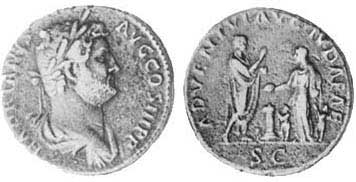Ancient Jewish Coins: Coins from Hadrian’s Trip to Judaea
(130 CE)
The Roman Emperor Hadrian (117-138 CE) visited many of the Roman provinces, including Judaea in 130 CE. Immediately, the rumor spread among the Jewish inhabitants that the Emperor, one of the great ancient builders, intended to rebuild the Jewish Temple in Jerusalem. He did intend to build a temple on this holy site ... however it was to be a pagan Roman temple dedicated to the god Jupiter (Zeus). Leo Kadman writes: “The Jews watched the stones of the Sanctuary being used to erect temples for heathen gods. No choice was left to them but to interrupt the building of the Roman colony by force of arms before it was completed” (The Coins of Aelia Capitolina).
Whichever of the Roman provinces Hadrian visited - Egypt, Macedonia, Spain, etc. - commemorative coins were issued, and the Judaean visit was no exception. His ADVENTVI AVG IVDAEA bronze sestertius shows the Emperor receiving a Jewish woman and two children who carry palm branches; in the background, a bull appears next to a sacrificial altar. The altar was a reference to the god Jupiter Capitolinus, to whom Hadrian had dedicated his new pagan temple. Hadrian even renamed Jerusalem as Aelia (his family name) Capitolina.
 |
|---|
Hadrian Sestertius, c. 130-132 CE (Reif. 34, 35)
Sources: The Handbook of Biblical Numismatics


